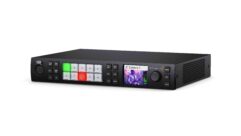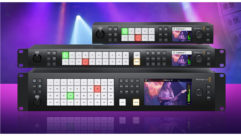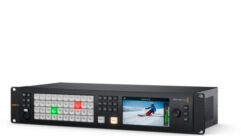

Product at Work: Blackmagic Design Atem 1 M/E
Dec 21, 2011 11:46 AM
Increasingly switchers play a role in pro AV. Our industry needs small, affordable options for non-standard applications; our users are not broadcasters in the traditional sense. In 2009, a 37-year-old broadcast company, Echolab, debuted the ingenious Atem switcher—and then closed in mid-2010 before they could realize its full potential. Coincidentally, Echolab’s retired co-founder Ted Whittaker (who also co-founded Broadcast Pix) died a few months later, and the Atem found a new home at Blackmagic Design.
The Atem 1 M/E production switcher is a broadcast-quality SDI switcher with HD and SD switching capabilities, as well as effects and graphics. At $2,500, it comes in a 2RU size and includes eight total inputs (four SDI and four HDMI) and SDI, HDMI, and analog outputs including down-converted SDI output and USB 3.0.
We’re going to look at two very different applications of the switcher. In one application, the Atem plays a research role in helping scientists analyze and present data at sea; in the other, the Atem is the centerpiece of an affordable production truck for regional users.
Switcher at Sea
Late last summer, the 274ft. research vessel Thomas G. Thompson, left Seattle on the Visions ’11 expedition, a co-venture with the National Science Foundation’s Ocean Observatories Initiative (OOI) and the University of Washington’s School of Oceanography. The expedition was to continue the ongoing installation of OOI’s high-power/high-bandwidth-cabled ocean observatory. This networked infrastructure of science-driven sensor systems measures the physical, chemical, geological, and biological variables in the ocean and seafloor and collects data as well as video from cameras on the floor of the Pacific.
So why a switcher? Beyond capturing, routing, and streaming live footage from 400 kilometers offshore and back to the university and online, the video infrastructure is instrumental in annotating and recording the scientific video—which was the primary deliverable from the cruise. This video had to be sent between various devices in a sophisticated chain that included embedding positional data in the HD 708 closed-captioning space. And the system, organized by video project manager Ed McNichol, would need to be flexible enough to adapt to the unpredictable needs of the research team. McNichol chose an Atem 1 M/E production switcher, and sister products Micro Videohub, and OpenGear Converters.
The Atem also enabled a full-featured production system for communication efforts that were seen by a land-based audience over a high bitrate satellite connection. These ongoing productions included live webcasts, recorded highlights, standups, and full-screen motion graphics.
The satellite connection was also used to teach classes from sea—including remote classes for students at the University of Charleston, South Carolina. Recorded segments came off a Mac Mini as QuickTime movies and fed into the Atem switcher, eliminating the need for external signal conversion.
The one feature of the Atem switcher that McNichol used most frequently was the included plug-in for Adobe Photoshop. “During many of our live shows, the chief scientist would interact on camera with a crew member who happened to be nearby. I did not have prepared lower thirds for everybody. But I was able to quickly jump over to Photoshop, enter the text, and send the graphic directly to a frame buffer in the switcher,” McNichol says.
Due to the large number of sources, McNichol was able to extend the capability of the Atem switcher by combining it with the Videohub. “All of the HD-SDI inputs were fed from the Micro Videohub, so I could feed any of my available sources into the switcher instantly,” he says. “I did opt for a hardware control panel for the Videohub, which uses a standard network connection. That proved to be a good decision.”
To make signal flow simpler, McNichol embedded analog audio content into an HD-SDI signal at the earliest possible point via Blackmagic Design’s OpenGear Converters.

Switcher on the Road
The content is football in Farmington, Ill., or a Pop Warner game in Eureka, or a corporate event in Peoria. ScheffTech Productions, one of Illinois’ busiest live production and remote television providers, caters to everyone including colleges and high schools, local governments, and businesses.
ScheffTech has to be mobile, flexible, and work with a myriad of infrastructures at the different venues, and with different crews around the state. These various requirements—including the need for affordable HD—inspired ScheffTech’s smaller sized TV production truck, which provides quality broadcasts at a cost that made sense for the local market.
At the core of ScheffTech’s live production infrastructure are the Atem 1 M/E production switcher, and Blackmagic Design’s SmartView Duo, Micro Videohub, and numerous Mini Converters and OpenGear Converters. With the fall school sports seasons in full swing, ScheffTech has used the Atem production switcher family for more than a two dozen live productions since August.
Typical live productions for ScheffTech use five Sony HXRNX5U cameras, shooting in 720p. ScheffTech fills the Atem 1 M/E production switcher’s other inputs with various audio tools to capture announcers, and in-game audio and Adobe Photoshop for character generation.
“Flexibility and reliability are key components to what I needed,” Brian Scheff says. “I have some productions where the venues are prewired with analog cables and some with fiber. Combining the Atem switcher with Blackmagic Mini Converters allows us to adapt to any venue.”
The Atem 1 M/E production switcher’s graphics and keying features also play an important role with ScheffTech’s many live sports productions, supporting replays, player and game stats, and wipes and effects on top of the basic switching capabilities.
Atem 1 M/E production switchers come with four upstream keyers, each with chroma, shaped and linear keying, two downstream keyers, stinger effects, graphic wipes, and media players for stills and clips for a full range of broadcast-quality effects. When combined with the built-in DVE for transitions or key positioning, ScheffTech has full control of their effects, including size and rotation control; high-quality push, squeeze, and move animations; customizable 3D borders; and filtering.
The Atem 1 M/E production switcher also comes with a built-in, cost-saving single multiview to allow 10 channels of video to be displayed on a single SDI or HDMI TV or monitor. Views are fully routable, and ScheffTech can use any external monitor as its viewing source. Also ScheffTech is able to manage the views to fit each event by being able to change the basic multiview layout, customize labels, and set safe area markers on preview displays and use the multiview’s tally feature to separate on-air and preview sources.
ScheffTech’s production truck includes Blackmagic’s Micro Videohub router, Smart Control routing control panel, SmartView Duo dual-screen rackmounted LCD monitor, and multiple Mini Converters and OpenGear Converters.
The Micro Videohub and Smart Control handle the routing of all signals in and out of the truck. Mini Converters and Open Gear Converters are used to change between HD SDI media and HDMI signals that can be used with the rest of ScheffTech’s technology, as well as for converting analog signals for monitoring.
For replays, ScheffTech relies on the combination of the Micro Videohub, Smart Control, and SmartView Duo. With the SmartView Duo directly controlled by the Smart Control attached to the truck’s Micro Videohub, the replay operator is able to view different camera angles, make directing decisions and set up replays at the push of a button.










